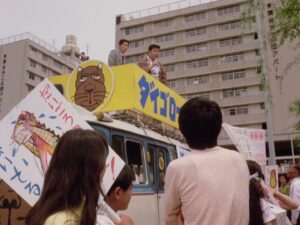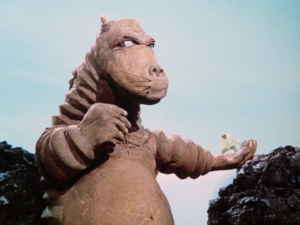Although landmark titles like Godzilla and Mothra have been blessed with English-friendly releases on home video, plenty of Toho’s genre catalogue remains unreleased. With many also unavailable on Blu-ray in Japan, one such example is the collaborative effort of Daigoro vs. Goliath with Tsuburaya Productions, released to Japanese cinemas on 17 December 1972. This piece will explore the film’s production, almost non-existent releases on home video, and the relatable themes that arguably still echo to this day.
Tsuburaya Productions, creators of the Ultraman franchise, originally planned a historical drama series for their 10th anniversary production, but instead opted for a kaiju film with Toho, due to budget restrictions and the former genre being too bureaucratic in nature. The project was then taken on with Toshihiro Ijima to direct, known for directing a multitude of episodes of Ultra Q, Ultraman, and Ultra Seven, and eventually writing episode 32 of Return of Ultraman (under the name Kitao Senzoku).
The first script drafts by director Ijima (also under the name of Kitao Senzoku) were that of a Godzilla adventure, originally planned allegedly as early as 1970, with the titular character facing off against another monster named “Redmoon”. This would eventually become the treatment for Daigoro vs. Goliath, with Godzilla instead being held off until Godzilla vs. Hedorah in 1971. No concept art has ever surfaced of the original story, aside from fan art later on produced by ‘Hurricane’ Ryu Hariken.
Daigoro vs. Goliath was also released as part of Toho’s Champion Festival, a twice-yearly cinema event marketed towards children that ran from 1969 to 1978. The festivals showcased new films primarily aimed at children, alongside re-cut versions of Toho SFX titles such as Destroy All Monsters and The Mysterians. These re-cut versions focused on action scenes and tended to remove filler dialogue as much as possible, shortening the films to just over an hour in length.
Billed as a “modern day fairytale” and comparable to a Walt Disney picture, Daigoro vs. Goliath revolves around an orphaned hippopotamus-like kaiju christened by its carers as “Daigoro”. This was different to the standard kaiju film at that time. While kaiju films of the period (like All Monsters Attack and classic-era Gamera) had featured human children as their heroes, Daigoro vs. Goliath has a monster child as its lead! Tense scenes involving destruction were, however, filmed with adults in mind. The film soon becomes a showcase of wild efforts made to raise money to keep Daigoro’s food shortages at bay. Meanwhile, a mysterious beast from the stars, named Goliath, ravages Japan, with Daigoro the only solution to the crisis.
The name “Daigoro” translates to “the great fifth son”, and is also the name of Itto Ogami’s child from the Lone Wolf and Cub series. The name is remarked in a flashback highlighting Daigoro’s discovery as a baby, after his mother is killed by the military. The name is then used as “atonement” for the matriarchal murder. There is further evidence of the name being taken from Lone Wolf and Cub, as the mother of the child character Daigoro in that series is also unjustly killed. Furthermore, four entries of Lone Wolf and Cub, and Daigoro vs. Goliath, were released the same year – and both by Toho.
As the film progresses, Daigoro struggles to keep his growth under control. In turn, this causes budget issues for his carer, Saito. Along with an “inventing uncle” referred to as “Ojisan”, and lager-lout carpenter Kumagoro, Saito tries in vain to keep Daigoro’s food problems at bay. Their desperate plans for money include bus campaigns and contest participations, with all schemes ending in almost complete failure and humiliation from the general public.

Focusing on the character of Daigoro himself, he’s frequently referred to for his weight. He’s known for his large appetite, and his appearance is outlined by his bulging stomach – which isn’t round, even, or what some would consider ideal. And yet, it’s how a stomach realistically looks when we put on a lot of weight. It’s normal! Daigoro is still seen walking around his island on casual strolls, eating plenty of nutrient-rich food such as fruit and vegetables. As Golda Poretsky outlined in her TEDtalk from 2013 on “Why It’s Okay To Be Fat”, as long as we are benefitting from participating in such behaviours, weight doesn’t matter.
The human characters helping with Daigoro’s struggles range from the young to the old, skinny statures to the large-and-in-charge, and all radiate a fighting and inspiring attitude in the hopes that Daigoro doesn’t just finish off Goliath, but that he can be accepted into society – a unification of different backgrounds for a positive cause. One such example could be the duo dynamics of Ojisan and Kumagoro, both opposite in appearances and personalities, yet both co-operatively working towards the same goal of saving Daigoro’s bacon – quite literally.
Kumagoro also displays a beacon of progressiveness upon finding his wife being given a bottle of special spring water by a friend during a small gathering at the family home, in the superstitious hopes that it will make her skin whiter. Reacting angrily, he prepares to swipe at his friend, declaring that his wife’s skin colour is no business of anyone. The notion of whitening skin is a recurring colonialist issue in Asian countries, not to mention elsewhere. Kumagoro’s stand against such a practice is admirable.
When Daigoro’s food source is replaced by water or anti-growth serum by the government due to budget restrictions, he becomes powerless and inept. Daigoro, up until the appearance of space monster Goliath, is seen as a strain on resources. He’s also wanted by a government official (played by Akiji Kobayashi of Ultraman fame) who plans to turn him into a marketable attraction for eventual profit – if Daigoro can learn the Hula Dance, that is!
The disdain towards Daigoro is then suddenly flipped upon Goliath’s arrival, as the now energy-depleted and starved monster is Earth’s only hope of repelling the beast back into the depths of outer space. This can be read as touching on societal disdain towards those considered marginalised – minorities, those with disabilities, etc. – which is only turned around when they become beneficial to the majority.

Environmental themes had become a prevailing theme in many kaiju productions at the time, spearheaded by such efforts as P Productions’ Spectreman series. This is true of the ’70s Godzilla and Gamera titles, and Daigoro vs. Goliath is no exception. This time, there is a focus on preserving nature, as Goliath has been drawn to Earth due to an under-protected atmosphere, much like the titular antagonist in Godzilla vs. Hedorah, who is attracted to the planet’s pollution. Nuclear weapons remain out of the question, as this would escalate things further.
Daigoro vs. Goliath has yet to see a physical release beyond DVD in Japan, although it has seen an Amazon Video exclusive in high definition. This version of the film is showcased with a recent transfer, attaining an unsurprisingly higher image quality than most of the current HiVision transfers that the Godzilla films in current distribution circulation use. This is due to Toho adopting newer and more advanced approaches to scanning their films, compared to their rushed efforts from over ten years ago. Whether or not this will eventually translate to a blu-ray release – as film companies move more to digital – remains uncertain. An English export version has never been produced or made available for licensing, although a translation effort was completed in 2011 by Hi No Tori Fansubs. This translates all of the dialogue and relevant on-screen text.
While cliché in some elements, and niche in others, Daigoro vs. Goliath is a heartwarming and wholesome family adventure. Daigoro proves that no matter where our identities lie, there’s a strong fighter in everyone. We have to be fully supportive of one another from the start to unlock that potential, despite any negative societal perceptions encountered.
It can be easily stated that there’s a certain degree of positive divergence that makes this piece of Japanese cinema exceptional, no matter how obscure or overlooked it may be. Toshihiro Ijima’s beautifully-crafted Daigoro vs. Goliath requires more attention, not just for being a Toho or Tsuburaya production, but as a distinctive parable of respect for ourselves and the people around us. With labels such as Mill Creek and Eureka releasing Toho and Tsuburaya offerings in English-friendly formats, and the film’s 50th anniversary next year, maybe Daigoro will finally advance to a well-deserved international debut.

